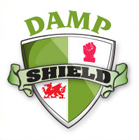Dampshield South Wales Ltd Contact Details
Contact
Mr Alan Rees
Email
Address
1 Gelli Hyll Road
Swansea
SA49WE
South Wales
About Dampshield South Wales Ltd
We can extract defective cavity wall insulation, causing little disturbance to the fabric of the building or to the occupant of the home. Dampshield South Wales can undertake the extraction of Rockwool, white wool, foam and bead insulation products from the cavity walls of domestic and commercial properties across South Wales.
This cavity wall extraction process is carried out for a number of reasons including:
Specialists in:
Contact us today:
Damp Proofing
Practically all building materials absorb water. This should not and need not be a problem. In reality water is the single most damaging cause of structural decay. It is responsible for more building maintenance costs than any other cause. Dry rot, wet rot, rising lateral and penetrating dampness along with condensation all arise because of unwanted and unnecessary water in buildings. These conditions create the perfect environment for the growth of fungi and the spread of wood-destroying insects. If treatment is delayed for any reason the damage will be much more than cosmetic. The fabric of the building will be damaged and its structural integrity threatened to a point where it will become unsafe. When the external signs become evident damage has already begun. There should be no delay in undertaking remedial work. Delay will incur additional risk and cost.
Rising damp is a very real possibility wherever a wall is in contact with the ground. The soil, which normally has high moisture content, acts as a reservoir. The wall exposed to the air causes the fabric of the wall to act as a ‘sponge’ drawing moisture up from the ground, through the bricks, stone or mortar. Depending on the construction and materials of the wall serious damage can occur anywhere up to 1.2 meters above ground level. Lack of a, or the presence of an ineffective, damp course will inevitably lead to rising damp and all the attendant damage that entails.
Wall Tie Replacement
It must be stressed that wall tie failure, or cracking of the outer leaf of a domestic property, is rarely an immediate threat to the safety of the occupants. The risk is greater to pedestrians and adjacent property, therefore measures must be taken to restrict access to the risk areas if severe wall tie failure is diagnosed.
Tanking
The term ‘Tanking’ refers to the application of a bonded membrane to a substrate, which will prevent the passage of ground water. This method of waterproofing is categorised as Type A within BS 8102. (The Sovereign Hey’di K11 Tanking System will provide Type A protection in accordance with this British Standard Code of Practice.)
Condensation Control
In winter months, when the problems of condensation are at their worst, most ventilation systems and extraction fans are switched off because they introduce cold air into the property. Similarly, open windows will lose heat and leave a property vulnerable to unforced entry. Our team at Dampshield confidently provide only the Sovereign Concure 20/20 systems with their unique, intrinsically safe heater that automatically resolves this problem by gently warming the air, which is to be circulated.
This cavity wall extraction process is carried out for a number of reasons including:
- Defective insulation material (such as Urea-formaldehyde) can break down and release toxic gasses. Early foam insulation had this risk and was not covered by the same stringent BBA certification licences or given the same 30 year guarantee through the Cavity Insulation Guarantee Agency (CIGA) as modern insulation materials.
- The cavity insulation gets wet, which breaks down the properties of the insulation. This can happen due to a number of reasons such as flooding, porous brickwork or mortar, or through a burst pipe in the attic.
- Poorly installed cavity wall insulation, installed with an incorrect drilling pattern or at the wrong density, can result in damp and condensation issues.
 |  |
Specialists in:
- Damp Proofing
- Wall Tie Replacements
- Timber Treatments
- Tanking
- Condensation Control
Contact us today:
- Free Surveys
- Free Quotations
- Fully Insured
 |  |
Damp Proofing
Practically all building materials absorb water. This should not and need not be a problem. In reality water is the single most damaging cause of structural decay. It is responsible for more building maintenance costs than any other cause. Dry rot, wet rot, rising lateral and penetrating dampness along with condensation all arise because of unwanted and unnecessary water in buildings. These conditions create the perfect environment for the growth of fungi and the spread of wood-destroying insects. If treatment is delayed for any reason the damage will be much more than cosmetic. The fabric of the building will be damaged and its structural integrity threatened to a point where it will become unsafe. When the external signs become evident damage has already begun. There should be no delay in undertaking remedial work. Delay will incur additional risk and cost.
Rising damp is a very real possibility wherever a wall is in contact with the ground. The soil, which normally has high moisture content, acts as a reservoir. The wall exposed to the air causes the fabric of the wall to act as a ‘sponge’ drawing moisture up from the ground, through the bricks, stone or mortar. Depending on the construction and materials of the wall serious damage can occur anywhere up to 1.2 meters above ground level. Lack of a, or the presence of an ineffective, damp course will inevitably lead to rising damp and all the attendant damage that entails.
Wall Tie Replacement
It must be stressed that wall tie failure, or cracking of the outer leaf of a domestic property, is rarely an immediate threat to the safety of the occupants. The risk is greater to pedestrians and adjacent property, therefore measures must be taken to restrict access to the risk areas if severe wall tie failure is diagnosed.
Tanking
The term ‘Tanking’ refers to the application of a bonded membrane to a substrate, which will prevent the passage of ground water. This method of waterproofing is categorised as Type A within BS 8102. (The Sovereign Hey’di K11 Tanking System will provide Type A protection in accordance with this British Standard Code of Practice.)
Condensation Control
In winter months, when the problems of condensation are at their worst, most ventilation systems and extraction fans are switched off because they introduce cold air into the property. Similarly, open windows will lose heat and leave a property vulnerable to unforced entry. Our team at Dampshield confidently provide only the Sovereign Concure 20/20 systems with their unique, intrinsically safe heater that automatically resolves this problem by gently warming the air, which is to be circulated.
 |  |
 UK
UK Ireland
Ireland Scotland
Scotland London
London











